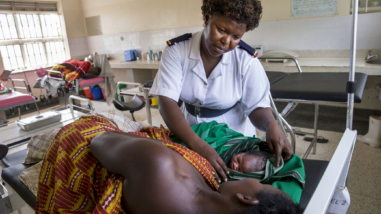Nothing to be afraid of. (Photo Credit: Flickr User Jonathan, licensed under CC BY 2.0)
People who work in philanthropy are often are urged to “take more risks,” but I think better advice would be to try to recognize how few risks we face—and run with it. While we don’t always take full advantage of the opportunity, many grantmakers can take three types of actions that are risky for government agencies that are directly accountable to the taxpayers and (hopefully) closely watched by the media, and for those in the for-profit sector who have a duty to shareholders. These three things are: abandoning the old for new (and maybe better) ideas, owning failure, and letting our contributions go unrecognized.
A foundation’s ability to help start up something new and untested is, I think, what most people think of as risk taking in the philanthropic sector. Many other types of funders find it extremely difficult to deviate from conventional ways of doing business, even if everyone agrees that the status quo isn’t quite working. Too many political and institutional hurdles prevent dollars from being moved from well-established programs to develop and test a new idea. And the risk-aversion of many funders plays out in the behavior of organizations they support: it can be a death-defying act for the leader of a non-profit organization to abandon a line of work that attracts dollars for one that, while promising, lacks a secure financial base.
Nowhere is this clearer than when we’re helping a new organization trying to get off the ground. Take our support to the African Center for Economic Transformation, for example. ACET was set up in 2008 as a regional think tank, with a plan to generate world-class research and provide advice to reform-minded African leaders. It was a new institution, trying a novel blend of scholarship and tailored support to tackle policy challenges—things like public sector reform, securing land tenure and easing access to land, and negotiations with investors in extractive industries. Many agencies that fund studies about African social and economic policy were interested and saw the potential value of African leadership on policy research. But they all found reasons not to divert resources from the “usual suspects,” primarily Northern think tanks and universities.
There were lots of questions: Would it be seen as legitimate? Would the leader, K.Y. Amoako, be able to attract high-caliber colleagues to Accra, Ghana? Would the research put new options on the table?
The only way to know was to try, and the only way to try was to provide unrestricted institutional support over several years. So we did. And in this case, it’s paid off. Using the start-up funds from the Hewlett Foundation and a few others, ACET proved itself, and answered all of those questions with a resounding yes. Now, current and future funders can invest in the work of an organization that has a solid track record of producing high quality work and having impact in complex African policy contexts. We took a calculated risk so that others would have a safer bet to make later on.
Some of the time, though, the new ideas don’t work out. Though, let’s face it, a lot of old, “we’ve always done it this way” ideas don’t work, either. The difference between the foundation world and more fraught environments, where politicians or investors are hovering around, is not that we can fail more. It’s that when we fail we can, if we choose, be honest and open about what went wrong, without facing significant negative consequences.
The latitude to reveal failure is not a given in a foundation; it comes from a Board and President who understand that real-world change is slow, difficult, and reversible, and who take a measure of pride in a reputation for candor and learning. What this means for those of us making the grants and evaluating their effectiveness is that we can look without blinders at whether the assumptions underpinning our strategies are wrong; and we can permit ourselves to ask hard questions about the current performance of organizations we’ve supported for a long time. These are not easy tasks, technically or psychologically, and you can’t tackle them every day without driving yourself into a state of paralysis. But it’s a gift to any professional to be able to reflect, talk, and write about the uncertainties that are intrinsic to our work: to doubt, to be curious and to learn. What this means for the fields in which we work is that we’re sometimes able to save others the trouble (and risk) of making the same mistakes we have.
We also are protected from the danger that our good works won’t be recognized. That is, we can be a quiet partner if that’s what’s needed. Foundations generally don’t face any risk at all if our biggest successes are not attributed to us. No amount of praise, no matter how well deserved, will change the size of our endowment. Again, this is very different than funders who depend on their reputation as good stewards of public dollars, and who are competing with other agencies. And it’s certainly different than leaders of non-profit organizations, who feel they must demonstrate to their supporters that they are having an outsized impact if they’re going to get them to pull out their checkbook once more.
In fact, I’ve come to see that much of the impact we’re seeking can only come if others—often those who have more resources but work in politically complicated environments—can cherry-pick winning ideas, make sizeable investments, and call them their own. As Harry Truman famously said, “It is amazing what you can accomplish if you do not care who gets the credit.” It is a motto for foundations to live by.
Having worked in other types of organizations, where the choices were often limited less by resources than by risk-aversion, I know a foundation can be a special sort of place. I don’t think we always take full advantage—perhaps because it’s hard for people to realize how free they really are—but one measure of our success should be how much we use our unusual perch to make the world a safer place for others.



